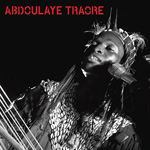|
|
 |
Dusted Reviews
Artist: Abdoulaye Traore Album: Abdoulaye Label: Yaala Yaala Review date: Sep. 23, 2010 |

|
|
|
 |
African popular and traditional music — however one chooses to define those terms — have a complex relationship with each other, as well as with the cross-Atlantic flow of recordings, musicians, and styles. Much of the popular music coming from Senegal, the Gambia and Mali since the early 1970s, although partly rooted in the Cuban and Puerto Rican genres that sloshed back and forth across the water for a hundred years, has also been re-rooted in local traditions. For example, mbalax combines griot songs and instruments (talking drums and kora harp-lutes) with Latin dance music, rock and blues. On the other hand, the wassolou style perhaps best known from the CDs and performances of Oumou Sangare, come not from the elite griot tradition but from the hunter caste. Thus although Sangare makes use of blues and funk much as Youssou N’Dour does, the traditional instruments are donso ngoni harp-lutes, the karinye iron clapper, and one or two calabashes covered with a net of cowrie shells.
The self-titled CD Abdoulaye Traore presents the listener with the hunter caste roots of wassolou in the form of eight tracks featuring two donso ngoni, karinye, calabash, and both solo and choral vocals — probably; one problem with the Yaala Yaala release is that no personnel are listed on the liner notes. A second problem: the disc was apparently remastered from Traore’s first cassette release in Mali, which may explains blasts of noise on “Dankoroba nyansan” and “Sadunun.” At any rate, the machine noises erupting on those tracks are left unexplained in the liner notes.
In spite of these shortcomings, the superb playing on the ngoni and Traore’s impassioned lyrics come through loud and clear. The ngoni, deeper in pitch than kora, are traditionally played in pairs, much like mbira in other parts of Africa, with both players performing variations on the same modal song in a steady ostinato. The effect is quite different from griot songs, in which the kora player alternates melodic runs with vocal lines. Here, as on the song “Koma Ko,” the alternation is strictly in the vocals, between the soloist and the chorus. The two ngoni play continuously, only occasionally breaking out in a run, with the karinye and calabash providing a steady eight or 12-beat pulse.
There is no denying the talent of Abdoulaye Traore and his uncredited compatriots, but there is a kind of sameness to the songs that is soothing rather than exciting. The liner notes provide brief descriptions of each song, but there are no translations, and no real context for understanding the descriptions. While having liner notes at all is an improvement over previous Yaala Yaala releases, the label still has a ways to go to make its releases appealing beyond the audience of DJs and ethnomusicologists who most likely form the bulk of its market at the moment. Of course, a full contextual treatment such as one might find with the old Ocora, Harmonia Mundi, or Nonesuch releases may well be an impossible ideal for a small label, but Strawn (who provided both the notes and a few photos) should take them as a model. If it had not been for the quality of notes provided on the early Nonesuch LPs of Javanese and Balinese gamelan music, the discs would not have been as popular as they were, stimulating much of the growth in appreciation and performance of that music in the 1970s and ’80s. There is much more to African music than soukous and hip-hop, but it will take more than this level of effort to bring out the potential audience.
By Richard Miller
|







